Vol. 17 No. 2
February, 1987
|
Stay Safe in 87
|

Hotel System
Linked to
the Railway
|
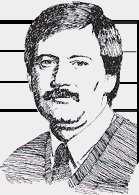
Dave Jones
Corporate
Archives
|
The formation of the Canadian Pacific hotel system, begun n 1886, is
inextricably linked to the early operations of the railway itself.
Operations on the mainline were opened in several stages, after the track was brought up to running standards and
the stations and ancillary structures were put in place.
As dining cars were not carried on long distance trains in the early 1880s, a system of dining halls was established
at several divisional points. While the locomotives were serviced, railway patrons could supplement their own
provisions with hot meals of reportedly generous proportions.
Such dining halls, built and operated by the railway, were opened during 1882 and 1883 at Winnipeg, Broadview, Moose
Jaw, Swift Current, Medicine Hat, and Canmore.
| |
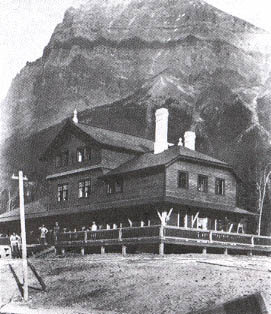
The Mount Stephen House 1886, at the foot of its
namesake.
|
For the mountain divisions, three additional dining halls were planned for Field, Glacier, and North Bend, all in
British Columbia. Before work was actually begun, however, two considerations brought about a major revision of the
original concept.
The need to provide accommodation for dining room staff in areas where communities were not yet established,
combined with the desire to promote these exceptionally scenic locations as tourist destinations, led to the
inevitable conclusion that small hotels would serve these purposes admirably.
Subsequently, William C. Van Horne, CPR's first chairman and second president, called upon Thomas Sorby, and English
architect already in the employ of the railway, to design a structure appropriate to the functions envisioned, to
suit all three locations.
The result was a picturesque Swiss chalet design, with three storeys in the center, two on one side, and a
one-storey wing on the other. Though the hotels were nearly identical at Glacier and North Bend, the
wings were reversed on the structure at Field.
While the hotels were under construction, dining cars were placed on sidings adjacent to the mainline to provide
meals for the patrons of the Pacific and Atlantic Expresses who could afford such extras.
The first of the mountain hotels to open was the Mount Stephen House in Field, at the summit of the Canadian
Pacific's line through the Rocky Mountains. It took its name from the imposing mountain which loomed up behind it.
On 23 Oct 1886, the doors were opened to begin serving passengers. The dining car Marlborough and its
staff were sent back east to attend to other duties.
The intention was for the railway's sleeping, dining, and parlor car department to operate the hotels, but it was
soon found to be expedient to entrust the operations to private entrepreneurs. The managers, of course, were
expected to keep the premises and furnishings maintained to "CPR Standards", while the company retained
ownership.
Mount Stephen House soon became a favorite with the travelling public and was frequented by a diverse group of
tourists, alpinists, hunters, and fishermen, not to mention the hungry passengers who descended upon the dining room
with the arrival of every train.
Among the early luminaries to cross the threshold were the Duke and Duchess of York in 1901, during the course of a
royal tour which took them throughout the British Empire.
One unexpected attraction, which drew members of the scientific community, was the abundance of fossil beds on the
slopes of Mount Stephen. So numerous were the beds that perfect specimens could be plucked from the surface without
one ever having to resort to pick or spade.
The hotel was a total success, so much so that a massive extension was added in 1901-2, completely
dominating the former structure and adding 50 bedrooms with up-to-date plumbing.
Designed by F.M. Rattenbury, who would later design the B.C. legislative buildings and the Empress Hotel in
Victoria, the addition included a large and impressive hall and billiard room with heavy beams and panelled walls
and ceiling.
A large new smoking room and drawing room with commanding views of the Kicking Horse valley added to the comforts
of the house, as did the enormous open fireplace in which whole logs could be burned.
Sadly, by the end of the First World War, economic conditions forced the railway to reconsider its hotel policy in
the area.
Tourists were beginning to favor automobiles as a convenient means of exploring the mountains, which thinned the
numbers of casual travellers using the railway; the wooden construction of the Mount Stephen House also made it
difficult to maintain first-class standards.
Accordingly, the entire building was turned over to the railway Y.M.C.A. organization and placed fully at the
disposal of the many itinerant railway workers who required accommodation at Field. It continued in this capacity
until 1953 when it was finally torn down and eventually replaced by a modest bunkhouse.
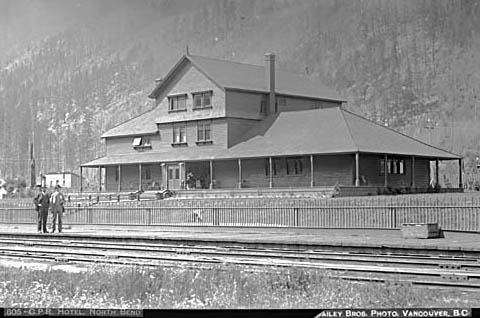
CPR North Bend Hotel - 1905.
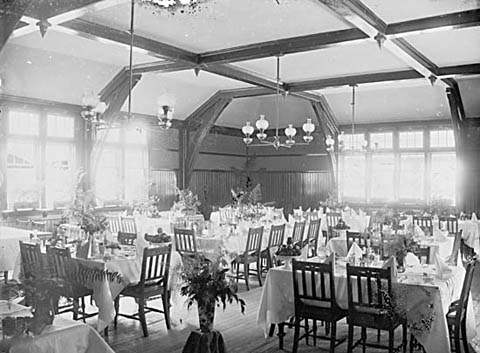
CPR North Bend Hotel dining room -
Date unknown.
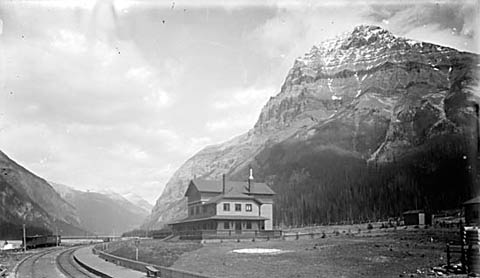
CPR Mount Stephen House Field B.C. - Date and photographer
unknown.
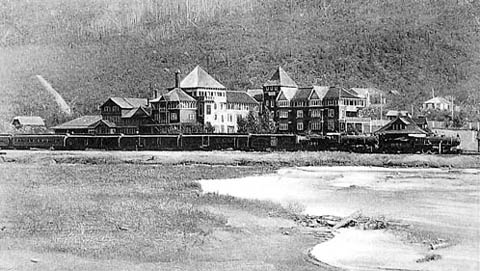
CPR Mount Stephen House Field B.C. - Date and photographer
unknown.
This Canadian Pacific Spanner article
is copyright 1987 by the Canadian Pacific Railway and is reprinted here with their
permission. All photographs, logos, and trademarks are the property of the Canadian Pacific Railway
Company.
|